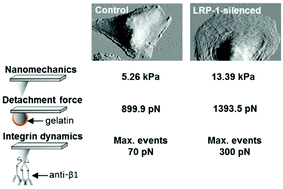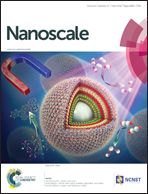Analysis of the effect of LRP-1 silencing on the invasive potential of cancer cells by nanomechanical probing and adhesion force measurements using atomic force microscopy†
Abstract
Low-density lipoprotein receptor-related protein 1 (LRP-1) can internalize proteases involved in cancer progression and is thus considered a promising therapeutic target. However, it has been demonstrated that LRP-1 is also able to regulate the endocytosis of membrane-anchored proteins. Thus, strategies that target LRP-1 to modulate proteolysis could also affect adhesion and cytoskeleton dynamics. Here, we investigated the effect of LRP-1 silencing on parameters reflecting cancer cells’ invasiveness by atomic force microscopy (AFM). The results show that LRP-1 silencing induces changes in the cells’ adhesion behavior, particularly the dynamics of cell attachment. Clear alterations in morphology, such as more pronounced stress fibers and increased spreading, leading to increased area and circularity, were also observed. The determination of the cells’ mechanical properties by AFM showed that these differences are correlated with an increase in Young's modulus. Moreover, the measurements show an overall decrease in cell motility and modifications of directional persistence. An overall increase in the adhesion force between the LRP-1-silenced cells and a gelatin-coated bead was also observed. Ultimately, our AFM-based force spectroscopy data, recorded using an antibody directed against the β1 integrin subunit, provide evidence that LRP-1 silencing modifies the rupture force distribution. Together, our results show that techniques traditionally used for the investigation of cancer cells can be coupled with AFM to gain access to complementary phenotypic parameters that can help discriminate between specific phenotypes associated with different degrees of invasiveness.


 Please wait while we load your content...
Please wait while we load your content...